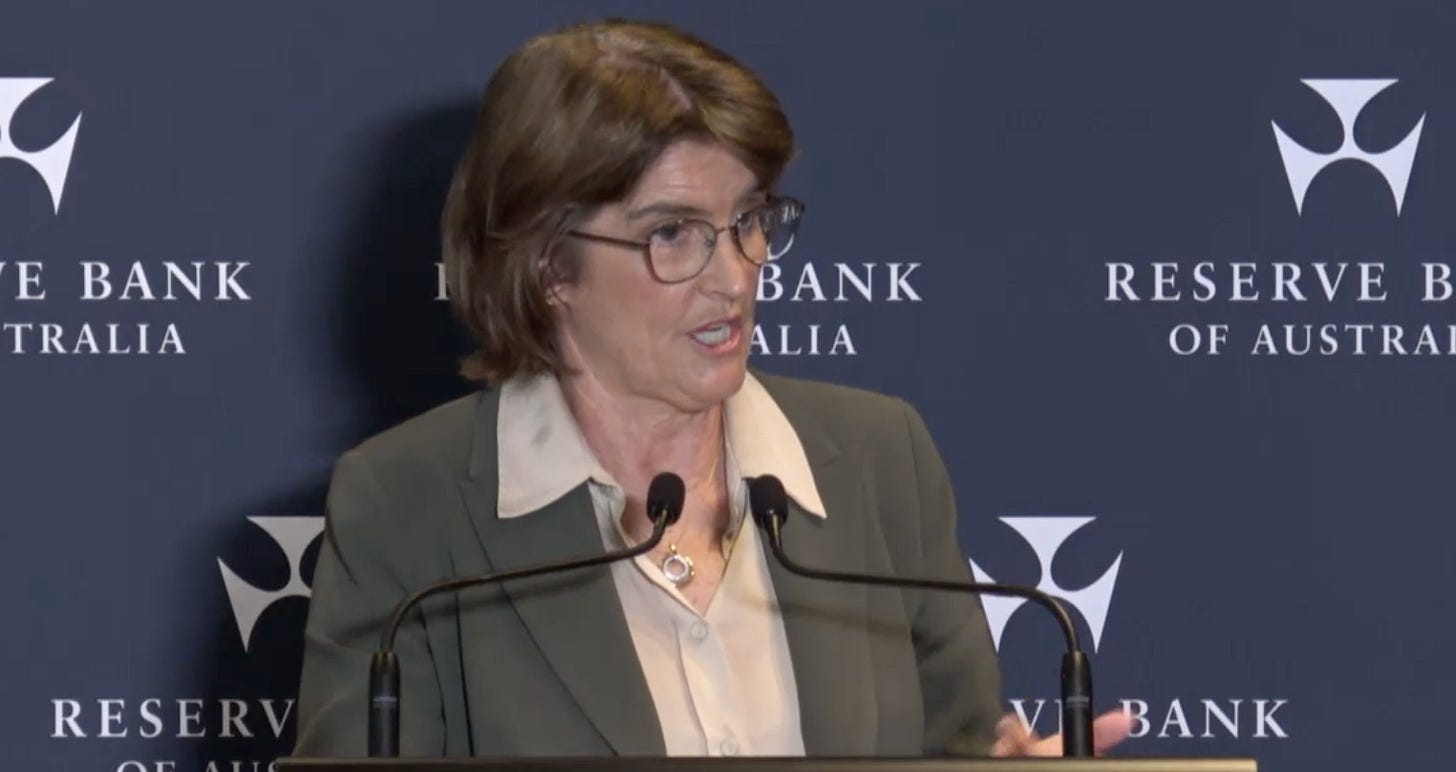This piece is freely available to read. Become a paid subscriber today and help keep Mencari News financially afloat so that we can continue to pay our writers for their insight and expertise.
Today’s Article is brought to you by Empower your podcasting vision with a suite of creative solutions at your fingertips.
Video courtesy by Reserve Bank of Australia
Reserve Bank Governor Michelle Bullock warned Tuesday that inflation could prove more persistent than forecast while announcing the central bank would hold interest rates steady, declining to predict whether Australians will see further relief from borrowing costs this year.
The Monetary Policy Board voted unanimously to keep the cash rate at 3.60%, marking a pause after three cuts delivered earlier in 2025. Bullock said recent data suggest upward pressure on prices beyond what the bank expected in August, though she emphasized the economy remains “in a good spot.”
“Inflation remains within the target range, but recent data indicate there could be a bit more upward pressure than we thought in August,” Bullock told reporters during a news conference following the board meeting. “Recent data, while partial and volatile, suggest that inflation in the September quarter may be higher than expected at the time of the August Statement on Monetary Policy.”
The governor repeatedly declined to provide guidance on future rate movements, saying decisions will depend on incoming data and updated forecasts available at the board’s November meeting.
Truth matters. Quality journalism costs.
Your subscription to Mencari directly funds the investigative reporting our democracy needs. For less than a coffee per week, you enable our journalists to uncover stories that powerful interests would rather keep hidden. There is no corporate influence involved. No compromises. Just honest journalism when we need it most.
Not ready to be paid subscribe, but appreciate the newsletter ? Grab us a beer or snag the exclusive ad spot at the top of next week’s newsletter.
“I’m not going to predict what the interest rate is going to be in the next three to six months,” Bullock said when pressed by reporters. “We’ll make that decision in November about whether it’s down again or maybe it’s hold again.”
Both headline and trimmed mean inflation remained within the bank’s 2-3% target range, with the unemployment rate holding steady at 4.2% in August. Bullock described labor market conditions as remaining “a little tight” relative to full employment despite slower employment growth in recent months.
“We have inflation basically in the 2% to 3% range. The unemployment rate is holding at around 4.2%,” Bullock said. “We expect it will drift up a little bit, but we still expect it to be relatively low compared with history.”
The governor said monthly inflation data, while volatile, showed concerning trends in market services and housing costs over the past two months of the September quarter.
“A couple of components are market services and housing inflation. We’re a little higher than we’re expecting, so we’re just being a little bit cautious about that,” Bullock said. “It doesn’t, I don’t think, suggest that inflation is running away, but we just need to be a little bit cautious.”
Bullock emphasized that monetary policy adjustments take time to flow through the economy, noting that three rate cuts delivered since the beginning of the year are still having effects.
“Monetary policy works with a lag, though, so the full impact of recent reductions on the economy are yet to be seen,” she said. “We know that there’s some impact of that starting to happen, but we know that there’s more to come.”
The governor welcomed signs that private sector demand, particularly household consumption, is recovering as real incomes rise and wealth increases through higher housing and share prices.
“The June quarter national accounts also gave us a bit more confidence that a recovery in the private sector demand, particularly household consumption, is progressing as we expect,” Bullock said. “That’s actually welcome because it’s reflecting that they’re feeling better about things.”
However, she cautioned the bank must remain alert to ensure demand doesn’t increase faster than the economy’s capacity to supply goods and services.
“We just have to be alert to the fact that demand doesn’t increase more quickly than the supply capacity of the economy to provide the goods and services,” Bullock said.
When asked whether the bank maintains an easing bias or has shifted to a neutral stance, Bullock said determining the appropriate policy level remains difficult.
“I think we feel that it’s still probably a little bit restrictive policy. We certainly don’t think it’s very restrictive and we certainly don’t think it’s very expansionary,” she said. “That’s why we have to be data dependent. We have to see what the outcomes are looking like.”
Bullock addressed growing concerns about housing affordability, acknowledging the situation facing first-time buyers but saying the central bank cannot target property prices.
“It’s a very, very difficult situation, David, and as an individual and as a citizen, I think we’re in a very difficult position with the property market, and I don’t actually think that most reasonable people think that this is a good outcome,” Bullock said when asked about families priced out of homeownership.
The governor said housing market problems stem from structural supply deficits rather than monetary policy settings.
“The problem in the housing market is a structural deficit of supply. That is the problem,” Bullock said. “And governments now get that, and you are seeing some action on that, but it’s going to be slow to work its way through.”
When pressed on her confidence that government housing initiatives will succeed, Bullock expressed skepticism about near-term impacts.
“I’m not confident it’s going to make any impact in the next two years,” she said. “The bottom line is that all I can do is make sure I keep inflation stable and I keep employment as strong as possible because that gives people the best opportunities to get jobs and be able to possibly get into the market.”
Bullock also addressed public confusion about falling inflation versus elevated price levels, emphasizing that prices will not return to pre-pandemic levels.
“I just want people to understand that when we’re lowering inflation, that doesn’t mean we’re lowering the price level. We’re lowering the rate at which prices are increasing,” she said. “The price level we are at is history. It’s done. What we’re focusing on now is making sure that we keep inflation low and stable.”
The governor discussed sticky services inflation, noting similar patterns overseas where goods price inflation has fallen but services costs remain elevated.
“One thing about market services inflation is that it often reflects the labour market because market services often have a high input from labour,” Bullock said. “We know that many countries overseas are also experiencing services inflation above levels that are comfortable.”
Global economic uncertainty also factored into the board’s decision. Bullock said data from China came in weaker than expected, while U.S. indicators showed mixed signals with weak employment but relatively strong activity.
“The Board sees the risks as broadly balanced and it remains data-driven,” she said.
Looking ahead, Bullock said the Australian Bureau of Statistics will introduce full monthly consumer price index reporting in November, replacing the current partial indicator. She cautioned the new monthly data will be more volatile than quarterly figures and emphasized the bank’s focus remains on quarterly trimmed mean inflation.
“The monthly CPI will be more volatile than the quarterly. It just will, because it will be monthly data rather than quarterly data,” Bullock said. “Our focus is the quarterly trim mean. We think that’s the best measure of underlying inflation.”
The governor outlined potential scenarios that could affect future policy decisions. An upside scenario involves consumers increasing spending as wealth rises, which she described as potentially positive for businesses and employment even if it limits further rate cuts.
“One upside scenario is a positive one, that they react to that and they start consuming again. That’s good for business, good for employment,” Bullock said. “So that’s not a bad news scenario, and if that means that we don’t lower interest rates further, then I wouldn’t say that’s necessarily a bad news story.”
Conversely, ongoing global uncertainty and low consumer confidence could dampen the recovery and weaken labor markets, potentially requiring different monetary policy responses.
When asked whether the bank could cut rates even if quarterly inflation isn’t falling, Bullock said decisions depend on the broader outlook.
“It all depends on what we think the outlook for the economy is,” she said. “What we’re focusing on is an interest rate path that will deliver us inflation sustainably in the band. That could mean a couple more reductions. It might not. I don’t know at this point.”
The central bank’s next monetary policy meeting is scheduled for November, when the board will review September quarter inflation data, updated labor market figures and revised economic forecasts.
Bullock concluded by framing the current situation as fundamentally positive despite uncertainties.
“We have inflation back in a 2% to 3% band, both in underlying and headline. We’ve got employment around full employment, maybe a little bit on the tight side. That is all really good positive news,” she said. “I can’t say what that means for next month or the month after because it is going to depend on what the data tell us.”
Sustaining Mencari Requires Your Support
Independent journalism costs money. Help us continue delivering in-depth investigations and unfiltered commentary on the world’s real stories. Your financial contribution enables thorough investigative work and thoughtful analysis, all supported by a dedicated community committed to accuracy and transparency.
Subscribe today to unlock our full archive of investigative reporting and fearless analysis. Subscribing to independent media outlets represents more than just information consumption—it embodies a commitment to factual reporting.
As well as knowing you’re keeping Mencari (Australia) alive, you’ll also get:
Get breaking news AS IT HAPPENS - Gain instant access to our real-time coverage and analysis when major stories break, keeping you ahead of the curve
Unlock our COMPLETE content library - Enjoy unlimited access to every newsletter, podcast episode, and exclusive archive—all seamlessly available in your favorite podcast apps.
Join the conversation that matters - Be part of our vibrant community with full commenting privileges on all content, directly supporting The Evening Post (Australia)
Catch up on some of Mencari’s recent stories:
It only takes a minute to help us investigate fearlessly and expose lies and wrongdoing to hold power accountable. Thanks!













